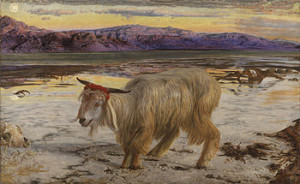The reading at Morning Prayer today is from Leviticus 16, and includes the story of the scapegoat:
Then he [Aaron] shall take the two goats, and set them before the LORD at the door of the tent of meeting;
[8] and Aaron shall cast lots upon the two goats, one lot for the LORD and the other lot for Azazel.
[9] And Aaron shall present the goat on which the lot fell for the LORD, and offer it as a sin offering;
[10] but the goat on which the lot fell for Azazel shall be presented alive before the LORD to make atonement over it, that it may be sent away into the wilderness to Azazel.and Aaron shall lay both his hands upon the head of the live goat, and confess over him all the iniquities of the people of Israel, and all their transgressions, all their sins; and he shall put them upon the head of the goat, and send him away into the wilderness by the hand of a man who is in readiness.
[22] The goat shall bear all their iniquities upon him to a solitary land; and he shall let the goat go in the wilderness.
William Holman Hunt (1827-1910) painted “The Scapegoat” when he visited the Holy Land in 1854. Wikipedia tells us
Hunt intended to experience the actual locations of the Biblical narratives as a means to confront the relationship between faith and truth. While in Jerusalem, Hunt had met Henry Wentworth Monk, a millenarian prophet who had distinctive theories about the meaning of the scapegoat and the proximity of the Last Judgement. Monk was particularly preoccupied with Christian Zionism.
Hunt chose a subject derived from the Torah as part of a project to convert Jews to Christianity. He believed that Judaic views of the scapegoat were consistent with the Christian conception of the Messiah as a suffering figure. He wrote to his friend Millais, “I am sanguine that that [the Scapegoat] may be a means of leading any reflecting Jew to see a reference to the Messiah as he was, and not as they understand, a temporal King.”[3]
The Book of Leviticus describes a “scapegoat” which must be ritually expelled from the flocks of the Israelite tribes as part of a sacrificial ritual of cleansing. In line with traditional Christian theology, Hunt believed that the scapegoat was a prototype for the redemptive sacrifice of Jesus, and that the goat represented that aspect of the Messiah described in Isaiah as a “suffering servant” of God. Hunt had the picture framed with the quotations “Surely he hath borne our Griefs and carried our Sorrows; Yet we did esteem him stricken, smitten of GOD and afflicted.” (Isaiah 53:4) and “And the Goat shall bear upon him all their iniquities unto a Land not inhabited.” (Leviticus 16:22)
However, Biblical literacy was never what it should be. Holman Hunt tried to sell the painting to Ernest Gambert, a French dealer. Holman Hunt recounts
Gambart, the picture-dealer, was ever shrewd and entertaining. He came in his turn to my studio, and I led him to The Scapegoat. “What do you call that?”
“The Scapegoat.”
“Yes; but what is it doing?”
“You will understand by the title, Le bouc expiatoire.”
“But why expiatoire?” he asked.
“Well, there is a book called the Bible, which gives an account of the animal. You will remember.”
“No,” he replied, “I never heard of it.”
“Ah, I forgot, the book is not known in France, but English people read it more or less,” I said, “and they would all understand the story of the beast being driven into the wilderness.”
“You are mistaken. No one would know anything about it, and if I bought the picture it would be left on my hands. Now, we will see,” replied the dealer. “My wife is an English lady, there is a friend of hers, an English girl, in the carriage with her, we will ask them up, you shall tell them the title; we will see. Do not say more.”
The ladies were conducted into the room. “Oh how pretty! what is it?” they asked.
“It is The Scapegoat.” I said.
There was a pause. “Oh yes,” they commented to one another, “it is a peculiar goat, you can see by the ears, they droop so.”
The dealer then, nodding with a smile towards me, said to them, “It is in the wilderness.”
The ladies: “Is that the wilderness now? Are you intending to introduce any others of the flock?” And so the dealer was proved to be right, and I had over-counted on the picture’s intelligibility.
(My art historian wife informs me that the last name of the artist is a double name “Holman Hunt” [despite Wikipedia] and it is without a hyphen, which would be jarring to the sensitive ear.)
